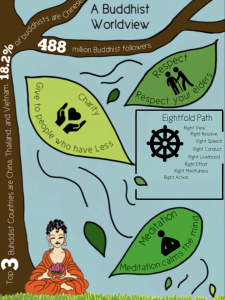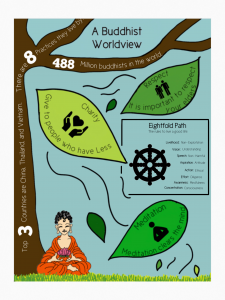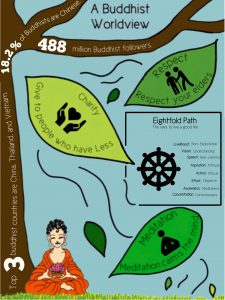 Imgine travelling through different religions in a matter of days! That’s what the grade 8 PLP class did. Not only did we learn in-depth about a variety of religions, we also had many field studies to visit local religious buildings to further our knowledge of each religion.
Imgine travelling through different religions in a matter of days! That’s what the grade 8 PLP class did. Not only did we learn in-depth about a variety of religions, we also had many field studies to visit local religious buildings to further our knowledge of each religion.
Before beginning our tour of religious buildings and temples, we were placed into small groups of four. Each group was given the task to research and eventually design and complete an infographic about a religion.
Unfortunatly, I was sick and was unable to attend our first two field studies the class went on which was to a mosque and a synagogue. During class, I learned that Muslims pray and cleanse themselves at least five times a day. To do this, a mosque will usually be equipped with some sort of sink and mats to cleanse and pray. Muslims pray regularly in a specific order. Before starting, one would usually remove all extra clothing such as coats and hats as well as any bags or additional luggage. They will then face the general direction if the holy town of Mecca and begin their prayer. Because Muslims categorize themselves as Christians, they believe in only one true God. However, another man by the name of Muhammad is also very well spoken of in the Islamic Religion. Muhammad is believed to be the last prophet and God’s messenger. For additional information on the Islamic Religion or any of the others below, please click on the link below ⤵️.
Due to sickness, I also missed my opportunity to visit a Jewish Synagogue. However, in class I discovered that Judaism aism and Christianity share the same founder and that Christianity branched off from the Jewish religion in the New Testiment of the Bible.
Over a few days, I got to visit a Hindu temple, a Chinese Buddhist temple, Sikh Temple and a Catholic Church. All of the buildings were equipped with all the needs a person may need to worship including altars, books and statues.
the Hindu temple was rather simple on the outside, however, once inside, the air smelled of Indian food and upstairs were many statues dressed in elaborate bright clothing. 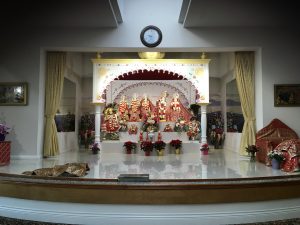 A traditional song was being played and fruit and flowers covered the altar/stage and the statues. I odserved many people as they came and left, praying and offering their offerings before the shrines.
A traditional song was being played and fruit and flowers covered the altar/stage and the statues. I odserved many people as they came and left, praying and offering their offerings before the shrines.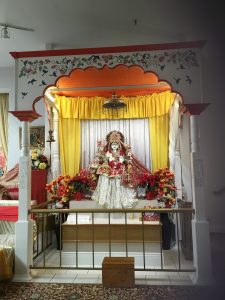 One interesting act I noticed was that a person would ring a bell before kneeling before a statue in prayer. I later learned that this was to alert the God that someone was there and willing to talk.
One interesting act I noticed was that a person would ring a bell before kneeling before a statue in prayer. I later learned that this was to alert the God that someone was there and willing to talk.
Right after our visit to the Hindu building, the class took a short drive to a Chinese based Buddhist temple. Buddhism is probably the most loosely tied religion with very few guidelines and rules. The decor on the inside and outside including theunique shape of the golden roofs indicated that this temple was based off of Chinese architecture. 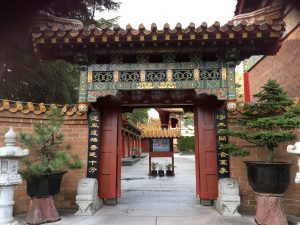 Once inside, the walls and corners of the building were covered by large golden statues of different Buddhas. One room even had thousands of miniature Buddha statues all embedded into the walls. This room also had pads in which people would kneel on to pray. A certain method of fortune telling was taught to us, where one shakes a tube of sticks. The first stick that falls out of the tube answers your question. The tour guide demonstrated this to us using a volunteer.
Once inside, the walls and corners of the building were covered by large golden statues of different Buddhas. One room even had thousands of miniature Buddha statues all embedded into the walls. This room also had pads in which people would kneel on to pray. A certain method of fortune telling was taught to us, where one shakes a tube of sticks. The first stick that falls out of the tube answers your question. The tour guide demonstrated this to us using a volunteer.  During class, I took note that Buddhists believe that a person’s afterlife is based on their previous life. All actions are believed to have a consequence called karma. One with good karma will be delivered to Nirvana and those with bad karma will be reborn back to Earth either as a human or animal. The goal of all Buddhists is to reach Nirvana. Since this was my groups religion, we took this opportunity to ask questions to help us with our study.
During class, I took note that Buddhists believe that a person’s afterlife is based on their previous life. All actions are believed to have a consequence called karma. One with good karma will be delivered to Nirvana and those with bad karma will be reborn back to Earth either as a human or animal. The goal of all Buddhists is to reach Nirvana. Since this was my groups religion, we took this opportunity to ask questions to help us with our study.
The class then visited a Sikh temple where we were treated to an amazing traditional lunch of Indian food. After that, we were guided into the main room of worship and a lady spoke to us about how to properly bow and meditate before the altar.  In class we learned about the importance of the Guru Granth Sahib which is a highly respected book of teachings in the Sikh religion as it is believed to be the word of God. Prayer is a central part of the belief. Sikhism prayers include meditation, hymns, devotionals and, like Islam, five daily prayers. Lastly, the class visited a local
In class we learned about the importance of the Guru Granth Sahib which is a highly respected book of teachings in the Sikh religion as it is believed to be the word of God. Prayer is a central part of the belief. Sikhism prayers include meditation, hymns, devotionals and, like Islam, five daily prayers. Lastly, the class visited a local 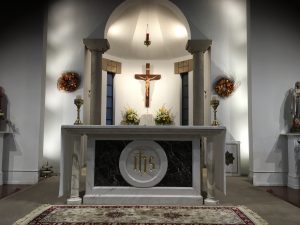 Catholic Church where we learned about the journey through this religion and how Baptism is an important step for Christians. We also were told about the birth and death of Jesus as well as the difference between Judaism and Christianity.
Catholic Church where we learned about the journey through this religion and how Baptism is an important step for Christians. We also were told about the birth and death of Jesus as well as the difference between Judaism and Christianity.
Once we visited all of these locations, our groups began to design and work on the infographic. In my group was Jordyn, Jackson and Taylor. The four of us began with a simple wire frame that included the main ideas we were going to write about as well as a quick outline of where the pictures, symbols and text boxes would be. My group then assigned each one of us a job and together, we put together an infographic. Below are all our drafts, and you might notice that there are more drafts in this project then any other projects I have posted. However, I learned a very important lesson: that you can never stop improving. And that every time you try again, you improve just a little bit more.
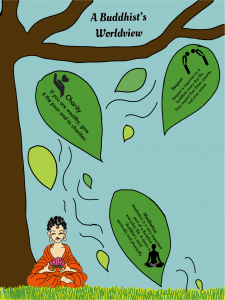
First Draft: Pretty much a replica of the wireframe with colour. Lots of text, big empty space, no pictures and overall sort of displeasing to the eye.

Draft #3: Clearer and words are better fitted to the leaves. Graph is kind of lacking something though and is very simple.
Besides the infographic, I also made a short Explain Everything video talking about my worldview. Before beginning the video, I was required to create a thought web using MindNode which I would then use to create my video using my most important aspects of my worldview.
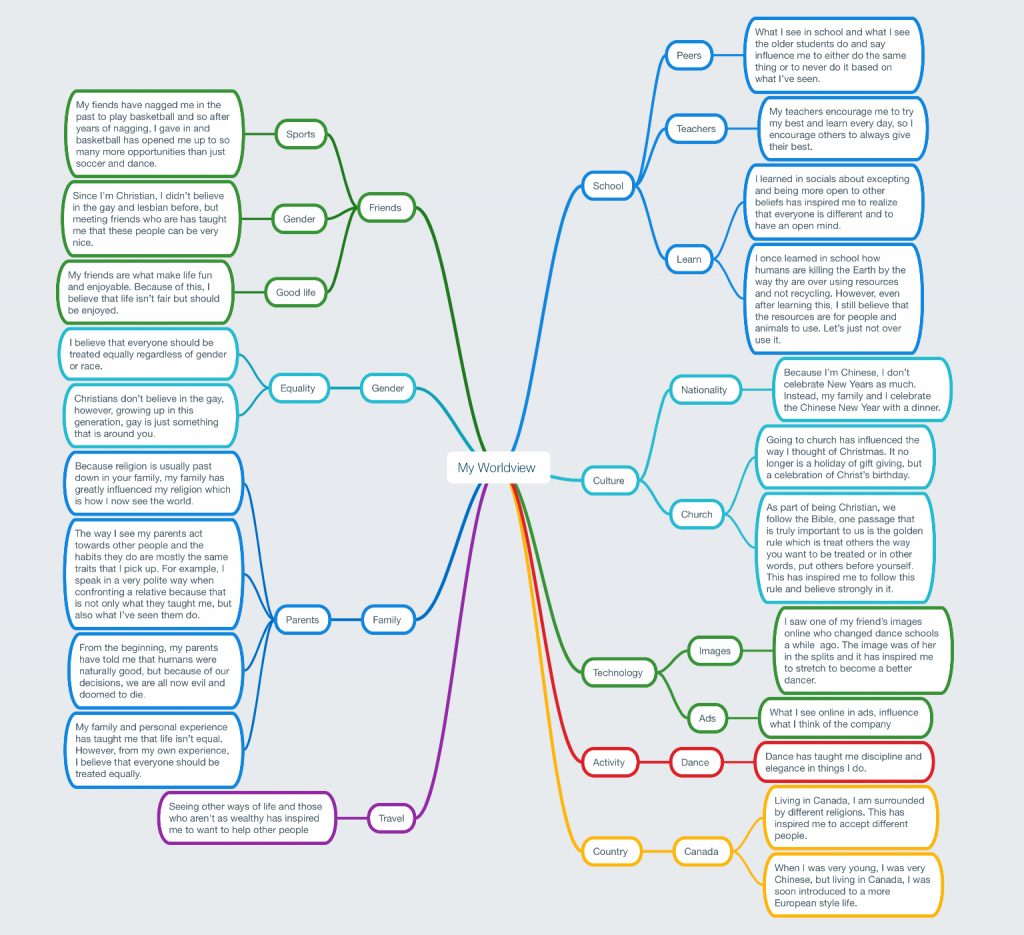
The chart showed different ways a persons worldview could be formed and influenced. I then filled in under each category, how these things influenced my personal worldview.
After the chart was completed, I made my Explain Everything. I made a few drafts but was unable to complete my final product due to sickness. As I didn’t want a sick voice as my new voiceover!😝



